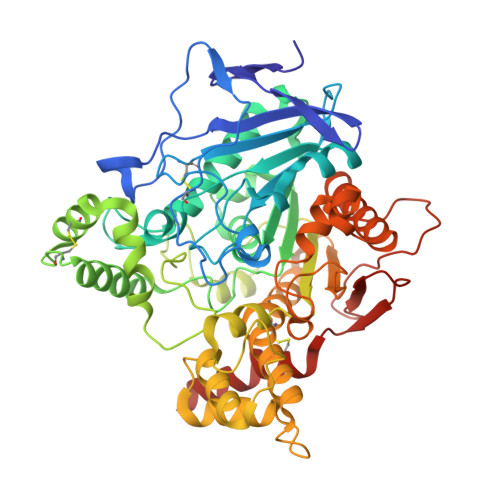Potent 3-Hydroxy-2-Pyridine Aldoxime Reactivators of Organophosphate-Inhibited Cholinesterases with Predicted Blood-Brain Barrier Penetration.
Zorbaz, T., Braiki, A., Marakovic, N., Renou, J., de la Mora, E., Macek Hrvat, N., Katalinic, M., Silman, I., Sussman, J.L., Mercey, G., Gomez, C., Mougeot, R., Perez, B., Baati, R., Nachon, F., Weik, M., Jean, L., Kovarik, Z., Renard, P.Y.(2018) Chemistry 24: 9675-9691
- PubMed: 29672968
- DOI: https://doi.org/10.1002/chem.201801394
- Primary Citation of Related Structures:
6EUC, 6EWK - PubMed Abstract:
A new series of 3-hydroxy-2-pyridine aldoxime compounds have been designed, synthesised and tested in vitro, in silico, and ex vivo as reactivators of human acetylcholinesterase (hAChE) and butyrylcholinesterase (hBChE) inhibited by organophosphates (OPs), for example, VX, sarin, cyclosarin, tabun, and paraoxon. The reactivation rates of three oximes (16-18) were determined to be greater than that of 2-PAM and comparable to that of HI-6, two pyridinium aldoximes currently used by the armies of several countries. The interactions important for a productive orientation of the oxime group within the OP-inhibited enzyme have been clarified by molecular-modelling studies, and by the resolution of the crystal structure of the complex of oxime 17 with Torpedo californica AChE. Blood-brain barrier penetration was predicted for oximes 15-18 based on their physicochemical properties and an in vitro brain membrane permeation assay. Among the evaluated compounds, two morpholine-3-hydroxypyridine aldoxime conjugates proved to be promising reactivators of OP-inhibited cholinesterases. Moreover, efficient ex vivo reactivation of phosphylated native cholinesterases by selected oximes enabled significant hydrolysis of VX, sarin, paraoxon, and cyclosarin in whole human blood, which indicates that the oximes have scavenging potential.
- Institute for Medical Research and Occupational Health, Ksaverska cesta 2, HR-10000, Zagreb, Croatia.
Organizational Affiliation:



















